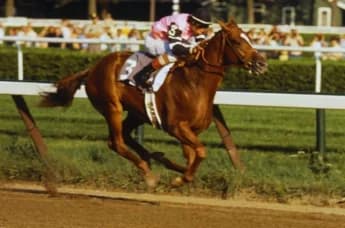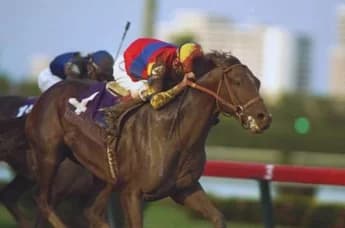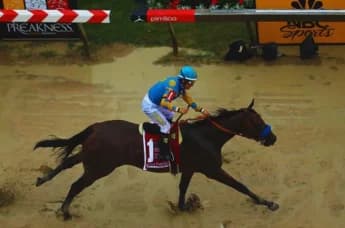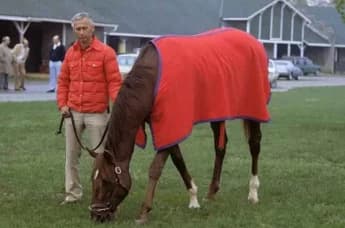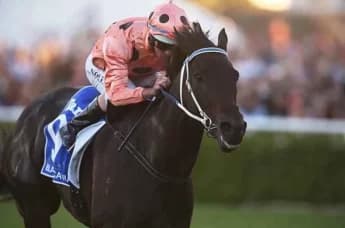Exterminator's story embodies the spirit of perseverance and excellence in horse racing, showcasing his remarkable journey from humble beginnings to legendary status on the track.
Exterminator is remembered as one of the most iconic and celebrated thoroughbreds of the 20th century in the history of horse racing. His legacy, which ranges from his modest beginnings to his extraordinary achievements on the racetrack, has made a significant impact on the sport. Over a career that lasted more than a decade, Exterminator became a symbol of resilience, determination, and an unwavering spirit. His victories in numerous races, combined with his exceptional consistency, transformed him from a promising young horse into a true champion, securing his place among the greatest racehorses of all time.
What makes the story of Exterminator so enthralling is the remarkable journey he undertook, filled with numerous challenges. Born in the early 20th century, he emerged from a background that lacked instant fame or immense expectations. However, through a combination of innate talent and unwavering determination, Exterminator captured the hearts of racing enthusiasts across the nation. He was not merely a competitor; he was a symbol of perseverance. Time after time, he validated his reputation by overcoming injuries, enduring tough races, and facing fierce competition, always coming out stronger. This remarkable resilience set him apart from his peers and became a defining characteristic of his career.
Exterminator's racing career is characterized by steady accomplishments alongside remarkable comebacks. While he may not have been the most eye-catching or dominant figure in the conventional sense, his achievements on the racetrack were irrefutable. Exterminator excelled in his capacity to cover great distances, both metaphorically and literally. Renowned for his stamina and endurance, he proved to be an unstoppable force in long-distance events, frequently overcoming late challenges and unleashing a burst of energy to pull ahead in the final moments. His skill in preserving form across diverse distances, varying conditions, and intense competition reinforced his status as a versatile and determined competitor.
Exterminator’s victories were not solely due to his natural ability; they also stemmed from a profound bond with his trainers and jockeys. With the skilled mentorship of trainer Henry McDaniel, Exterminator developed into a knowledgeable and adept competitor. Their relationship was founded on mutual understanding and respect. Additionally, his jockeys, such as Willie Knapp, were instrumental in his achievements, expertly guiding him while being attuned to his distinctive running style. This synergy between the horse and his team was a crucial factor in Exterminator’s lasting success.
Exterminator's achievements extended beyond mere victories; they were defined by the manner in which he won. His triumphs were characterized by a calm assurance, a strategic patience, and at just the right moment, an explosive surge of speed that left his rivals trailing. From clinching prestigious events such as the Brooklyn Handicap to celebrating success in the Saratoga Cup, Exterminator exemplified the belief that determination often paves the way to success. With every win, his stature grew, solidifying his legacy in the annals of horse racing with each passing season.
Although his racing career concluded in 1923, Exterminator’s importance in the world of horse racing has only intensified with the passage of time. His unwavering commitment to the sport, his resilience in overcoming challenges, and his capacity to thrive when others struggled have inspired countless generations of horse racing enthusiasts and athletes. In contemporary times, Exterminator stands as a brilliant exemplar of what it means to be a true champion — a horse whose determination and character were as significant as his victories. His influence on the world of horse racing is irrefutable, and his narrative continues to motivate those who cherish the sport, ensuring that his legacy endures eternally.
Formative Years and Heritage
The tale of Exterminator begins in the picturesque hills of Lexington, Kentucky, where he was born in 1915. This bluegrass area, famed for producing some of horse racing's most legendary figures, offered an ideal setting for the arrival of this future star. His sire, also named Exterminator, was distinguished for his remarkable performance under pressure, significantly influencing the young colt’s physical and mental fortitude. The name “Exterminator” would later become a fitting homage to the horse’s enduring spirit and unwavering nature, characteristics he consistently showcased on the racetrack throughout his illustrious career.
On the maternal side, Exterminator's mother, The Widow, played a significant role in shaping the colt's potential. The Widow was a mare known for her remarkable stamina and elegance; while she may not have achieved individual fame, her impact on Exterminator's genetics was profound. She imparted a calm temperament and robust endurance to her foal, qualities that would enable him to face long-distance races with unwavering resolve. As is the case with many outstanding racehorses, Exterminator's achievements were driven as much by his ancestry as by his own tenacity, and both branches of his lineage equipped him with the essential traits needed for success.
Exterminator was born into a lineage during a transformative time in American racing. The sport was thriving, with new champions emerging each season. However, Exterminator, even as a young foal, exhibited unique qualities that set him apart. He didn’t initially attract attention with flashy appearances or a commanding presence. Rather, he garnered the admiration of those around him through his humble demeanor and innate athletic abilities. His early years lacked the fanfare or high expectations often associated with great racehorses—he was merely a colt brimming with potential, awaiting the opportunity to shine.
The moment Exterminator was acquired marked a significant turning point in his life. He was bought by the partnership of McDaniel and James G. Rowe, an ownership group that recognized the potential in the young colt. Under their guidance, Exterminator was afforded the chance to evolve into the remarkable racehorse he would ultimately become. Their decision to invest in him was a wise one, as Exterminator began to enhance both his physical capabilities and racing skills as he matured.
One of the most notable aspects of Exterminator in his youth was his strong work ethic. While he may not have been regarded as an exceptionally gifted colt at first, he demonstrated his capabilities by diligently going through the training process and quickly adapting to it. His initial journey toward becoming a competitive racer was modest—he lacked the flashy appearance and immediate pedigree of greatness. However, what truly distinguished Exterminator was his relentless drive and determination. His early progression on the racetrack was marked by a gradual and steady approach, and this would ultimately define his character: a horse who didn’t require instant domination, but rather one who continuously grew stronger and wiser with each race he tackled.
The early training years of Exterminator were vital in shaping his future success. Trainer Henry McDaniel, who took charge of guiding Exterminator’s progression, played a significant part in honing the colt’s inherent abilities. McDaniel recognized qualities in Exterminator that others may have overlooked — a subtle strength and remarkable stamina that would later establish him as a formidable contender on the racetrack. His patience and grasp of the horse’s potential were essential in cultivating Exterminator into a racehorse capable of enduring challenges, both physically and mentally.
Although Exterminator was a late starter, the early training he received under McDaniel's mentorship helped him gain the self-assurance required to compete with top contenders. Gradually transitioning from a colt to a serious competitor, Exterminator developed a reputation for his quiet resolve. As he grew older, it became apparent that the solid and consistent foundation laid during his formative years had cultivated a horse of significant potential. While it was not immediately obvious that he was on the path to greatness, as his career progressed, it became clear that Exterminator was destined to make a lasting impact on the sport.
Looking back, it is clear that the combination of his sire Exterminator's strength, the steady guidance from The Widow, and the early support provided by his owners and trainers played crucial roles in shaping Exterminator into the horse that would ultimately enchant the racing community. His formative years were characterized by gradual development, diligent effort, and a robust foundation that set the stage for him to become one of the most lasting and cherished champions of his era.
Training and Racing Career
Exterminator’s journey to greatness was characterized by a gradual progression rather than a sudden rise. His success was built on perseverance, thorough training, and relentless determination. In his initial races, he encountered a blend of learning moments, victories, and obstacles that laid the groundwork for his remarkable career. Although he showed potential in his first season on the track, it was evident that he was not an overnight success. Over time, his true abilities came to light, showcasing a consistency and endurance that became hallmarks of his racing style. As Exterminator grew older, he began to display the traits that would establish him as a formidable competitor — not just for his speed, but also for his exceptional stamina.
Exterminator's racing career was significantly influenced by the steady guidance of his trainer, Henry McDaniel, whose patience and insight into the horse's temperament were crucial in shaping his journey to success. McDaniel's confidence in Exterminator's potential allowed the horse to cultivate a distinct racing technique—one that emphasized pacing and strategic positioning over quick bursts of speed at the start. He understood that Exterminator performed best in longer races, where his endurance and ability to gradually gain speed would provide an advantage over competitors who lacked the same stamina. This strategy enabled Exterminator to harness his natural talents, allowing him to excel in races that demanded both physical strength and mental resilience.
Exterminator was owned by James G. Rowe, a person who saw the colt's potential and remained committed to his development throughout his racing career. Under Rowe's care, Exterminator's growth was closely monitored, and he received the necessary resources to compete at the highest level. The collaboration between McDaniel, Rowe, and Exterminator created a foundation for a career marked by mutual respect, trust, and a unified vision for success. Together, they made sure that the horse was always in optimal condition, prepared to tackle the rigorous demands of competitive racing.
In terms of jockeys, Exterminator had the advantage of being partnered with some of the most skilled riders in the sport. Willie Knapp emerged as one of the principal jockeys in Exterminator’s career, playing a crucial role in several of his most notable victories. Knapp’s riding technique was a perfect match for Exterminator’s distinctive racing style; he instinctively knew when to conserve energy and when to urge his horse forward in the final moments of a race. Their collaboration was characterized by strategy, patience, and mutual understanding, enabling Exterminator to showcase his finest attributes on the racetrack. The synergy of McDaniel’s training, Rowe’s ownership, and Knapp’s riding helped propel Exterminator to the zenith of his career.
Exterminator achieved his first major milestone in 1918 by winning the Brooklyn Handicap, marking his inaugural significant stakes victory. This race was pivotal in establishing Exterminator’s reputation, as it proved his capacity to endure and triumph against elite contenders. The victory highlighted Exterminator’s exceptional stamina, revealing his proficiency in handling races that required endurance over sheer speed. His strategic racing style was apparent; rather than rushing ahead, he chose to position himself judiciously, enabling his stamina to propel him through the latter parts of the race. This achievement signaled the start of Exterminator’s rise as a formidable presence in American horse racing.
A pivotal moment in Exterminator’s career came with his victory in the Saratoga Cup in 1922. This prestigious event further enhanced Exterminator’s standing as a racehorse adept at tackling some of the most demanding challenges in the sport. During this race, he encountered fierce competition from other elite horses, yet once again, it was his stamina and composure that shone through as his greatest strengths. His powerful surge in the final moments of the race highlighted the effective training and confidence his team had in him. Winning the Saratoga Cup was one of the highlight achievements of Exterminator's career, demonstrating his capability to prevail against the top competitors in the field.
Beyond these esteemed victories, Exterminator gained recognition for his exceptional consistency amid competition. While other horses might tire as the race progressed, Exterminator appeared to become more powerful, presenting a challenge for any rival unable to match his pace. His hallmark racing technique—favoring endurance over sheer speed—set him apart as a distinctive competitor. Exterminator was not merely a fast horse; he was one that could sustain his velocity throughout lengthy races, frequently outpacing rivals who had exhausted themselves earlier on. His methodical and strategic racing approach not only made him a fan favorite but also propelled him toward legendary status.
Exterminator's racing career was characterized not by a handful of spectacular wins, but rather by a consistent series of achievements that showcased his distinctive racing style and unwavering determination to succeed. His victories embodied the true spirit of a champion: the ability to withstand challenges, adapt strategies, and consistently perform at a high level. His narrative is one of resilience, where the culmination of his steady efforts ultimately earned him a prominent position in the annals of horse racing history.
Significant Accomplishments
Exterminator's legacy will always be remembered in the history of horse racing, not only for his unwavering consistency but also for the extraordinary accomplishments that marked his career. Throughout his extensive career of 100 races, Exterminator achieved 50 victories, along with 18 second-place finishes and 12 third-place finishes, demonstrating a level of dependability that very few horses could attain. His enduring presence and capability to excel consistently over nearly a decade elevated him to the status of one of the most esteemed thoroughbreds of his time. His accomplishments extended beyond just wins; they included an impressive series of notable performances that set records and firmly established his place in racing history.
One of Exterminator's most significant victories occurred during the 1918 Brooklyn Handicap, a race that heralded the start of his ascent to fame. This win was crucial as it showcased Exterminator's ability to compete against the best horses of his era. Although the Brooklyn Handicap was already a prestigious event, Exterminator's triumph indicated that he was not merely another competitor — he was a horse capable of exceptional performances at major events. His consistent pacing, paired with remarkable endurance, enabled him to secure the victory, foreshadowing many successes to follow. This win established the foundation for his career, emphasizing his natural talent for excelling in races that required stamina and determination.
In 1922, Exterminator secured one of the most significant victories of his career by winning the Saratoga Cup, which was regarded as one of the most esteemed races of its time. This race drew the top horses from across the nation, providing an ideal platform for showcasing Exterminator’s abilities. Competing against some of the best contenders in the sport, his determination and stamina enabled him to outlast his rivals. His remarkable performance in this event, following several years of consistent racing, solidified his position as one of the top racehorses of his generation. This victory not only enhanced Exterminator’s accolades but also strengthened his reputation as a champion capable of overcoming the toughest challenges in the sport.
One of the most notable achievements of Exterminator occurred in 1923 when he secured a victory in the Kentucky Handicap. This win was particularly significant as it cemented his status as a national champion. The Kentucky Handicap presented a formidable challenge, drawing tough competition from some of the finest horses of the era. However, Exterminator’s strategic racing style, steady pacing, and ability to excel in longer distances enabled him to triumph and add yet another major victory to his already stellar portfolio. This achievement further enhanced his legendary status and established him as a fan favorite — a horse that exemplified both elegance and determination.
One of the most remarkable features of Exterminator's career was his capacity to excel under the harshest conditions. Not only did he consistently secure victories in major races, but he did so while contending against fierce competition in some of the most demanding events in the sport. The true strength of Exterminator lay not in his speed, but in his remarkable endurance, which enabled him to excel in long-distance competitions. This stamina was crucial to his success in the Clark Handicap (1922), a race that necessitated horses to sustain a high level of energy and focus throughout its entirety. Exterminator's strategic pacing and long-range tactics, coupled with his unwavering determination to win, afforded him an upper hand that few rivals could match.
Exterminator’s accomplishments went beyond mere victories; he established several significant records that solidified his legacy in horse racing history. Over the course of his career, he achieved an impressive 50 wins, earning him a place among the most accomplished racehorses of the early 20th century. His victories spanned a wide array of prestigious events, and his consistent performance in high-pressure races set him apart as truly remarkable. The blend of his speed, stamina, and strategic mindset enabled him to excel under various racing conditions, from short sprints to grueling long-distance races, showcasing a versatility that was rare among his peers.
Although Exterminator may not have exhibited the flashy speed or immediate brilliance of some of his contemporaries, his remarkable consistency, endurance, and capacity to triumph in various contexts established him as a true champion. His accomplishments in prestigious races like the Brooklyn Handicap, Saratoga Cup, and Kentucky Handicap, along with his record-setting performances, created the foundation of a career that remains celebrated today. His legacy goes beyond simple statistics; it is grounded in the lasting charm of a horse that exemplified perseverance and resolve. Exterminator didn't merely win races — he endeared himself to his supporters, securing his place as one of the most cherished figures in the history of American horse racing.
Character and Heritage
The legacy of Exterminator is not merely defined by his impressive race wins or the multitude of awards he received. His reputation was greatly influenced by his remarkable personality, both on the racetrack and in the stable, which made him a cherished figure in the horse racing world. While many exceptional horses are celebrated for their speed and athletic prowess, the true appeal of Exterminator resided in his steadfast determination, strong work ethic, and the affection he showed to those who took care of him. This unique blend of character and skill earned him a special place in the hearts of all who followed his journey.
Exterminator was recognized for his calm and easygoing disposition, making him the kind of horse who did not attract attention or create a fuss. In the stable, he was unpretentious, happily going about his daily activities. Yet, upon hearing the starting bell, Exterminator would transform into a determined and focused competitor. His trainer, Henry McDaniel, would often describe him as a “gentle giant” in the stable. Known for his friendly and affectionate nature, he presented a remarkable contrast to the fierce and determined athlete that appeared on race days. This gentle demeanor off the track made him a pleasure to work with, and his training regimen showcased the trust that McDaniel placed in him.
A touching story that truly illustrates Exterminator's character comes from one of his grooms, who recounted how the horse would frequently nuzzle his handler after a race, as if to express his gratitude for the care he had received. This capacity to forge connections with his human companions highlighted his gentle nature and the special bond he had with those around him. There was a strong sense of respect between Exterminator and his team, with every member of his crew attuned to his needs and dedicated to securing his success. Exterminator’s appreciation wasn’t always vocalized; instead, it was reflected in his demeanor and how he performed for those who believed in him.
The close relationship he had with his caretakers turned Exterminator into a beloved figure among fans. His easygoing personality, paired with a fierce drive to compete, positioned him as one of the most respected horses in the annals of racing history. The public was captivated by his narrative of triumphing over obstacles with poise, showcasing repeatedly that he was more than merely a racehorse — he epitomized resilience. Supporters frequently expressed how they admired not only his wins but also his composed demeanor, a striking contrast to the more typical, fiery natures of many other racehorses.
Exterminator was well-known as a competitor who embodied resilience and an unwavering spirit, making him a formidable presence on the racetrack. His legendary capacity to outlast rivals in long-distance events set him apart in the racing world. However, it wasn’t just his physical stamina that distinguished him; it was also his remarkable mental fortitude. Exterminator never allowed himself to be intimidated by his challengers. Whether facing the quickest sprinter or the most adept competitor, he maintained his poise, waiting patiently for the right opportunity to launch his challenge. This steadfast focus and resolve garnered him widespread respect from jockeys, trainers, and admirers alike.
Exterminator's reputation as a revered figure in the horse racing world extended far beyond his victories on the racetrack. He embodied the essence of an ambassador for the sport. His journey to success was characterized by teamwork and commitment, showcasing how the horse's relentless effort, alongside the skill and knowledge of his trainer and jockeys, culminated in a series of extraordinary achievements. Exterminator's triumphs epitomized the collaborative spirit of horse racing — a sport where the relationship between horse and rider is essential for reaching the pinnacle of success.
The legacy of Exterminator endured long after he hung up his racing shoes, not merely as a champion of numerous prestigious races, but as a horse who significantly enhanced the public’s appreciation of the sport. He embodied the belief that triumph in horse racing transcends mere speed; it’s fundamentally about resilience, spirit, and the unwavering determination to persevere through challenges. His passing in 1945 at the age of 30 prompted a wave of sorrow throughout the racing community. However, even in death, Exterminator’s legacy continued to thrive through the narratives shared about his remarkable life.
Exterminator is a beloved icon in the realm of American horse racing history. He is honored not only for his extraordinary accomplishments but also for his steadfast spirit, serene nature, and the profound respect he garnered from all those fortunate enough to be a part of his journey. His legacy continues to motivate fans, trainers, and jockeys, serving as a reminder that a true champion is not solely measured by wins, but also by the integrity and character demonstrated throughout their endeavors.
Retirement and Conclusion
Following a remarkable career lasting almost ten years and filled with numerous victories, Exterminator retired from racing in 1924, signaling the close of an era. Having achieved legendary status, he had rightfully earned the opportunity to leave the racetrack. His last race was the 1924 Saratoga Handicap, where he placed fourth — a fitting end for a horse that had triumphed over some of the greatest challenges in the sport. Although he was no longer competing in the limelight, his legacy in racing history was securely cemented, and his retirement was met with admiration from fans and fellow competitors alike.
Exterminator's transition into retirement was relatively effortless, as he shifted to a more tranquil lifestyle that balanced both relaxation and work. His years after racing unfolded at Claiborne Farm in Kentucky, where he became a cherished figure, celebrated not only for his racing achievements but also for his composed and dignified demeanor. Even though he had hung up his racing shoes, his popularity remained strong. He was frequently seen being cared for by the same grooms and handlers who had looked after him during his racing days, and he continued to earn the admiration and affection of those who had witnessed his extraordinary performances on the track. In many respects, his life after racing was as serene as the demanding years he had spent competing.
While Exterminator’s legacy was primarily forged through his impressive stamina and determination on the racetrack, he also had a brief stint as a breeding stallion. However, this aspect of his career was not as extensive as many might have anticipated considering his stature. Although his offspring did not achieve the same level of racing success as he did, there were a few who carved out respectable careers for themselves. The limited results from his breeding endeavors should not be seen as a testament to his inability as a sire, but rather as a reflection of the era. The demand for stallions during the early 20th century was quite inconsistent, and while Exterminator’s descendants didn’t reach the same heights of renown, his influence remained integral in the bloodlines of several racehorses, ensuring that his legacy continued through subsequent generations of the sport.
Although Exterminator’s period as a breeding stallion was relatively short, his reputation as a racehorse remained unmatched. His bond with the world of horse racing did not diminish during his retirement. Many visitors to Claiborne Farm would actively seek him out, and the stories of his illustrious racing career were shared across generations. The narratives highlighting his extraordinary stamina, gentle disposition, and hard-fought victories continued to enthrall racing fans and horse aficionados alike. Even after his racing days were over, Exterminator persisted as a symbol of resilience, demonstrating that true greatness transcends the racetrack.
Exterminator passed away in 1945 at the age of 30, which is quite an impressive age for a racehorse of his time. His passing was met with deep sorrow and admiration from the racing community. He spent his final years in the company of those who cared for him and appreciated the remarkable influence he had on the sport. He was laid to rest at Claiborne Farm, where his legacy was celebrated, and a gravestone marks the final resting place of one of the most esteemed thoroughbreds in American history.
The passing of Exterminator did not lessen his significance in the annals of horse racing. In fact, it only reinforced his status as one of the most cherished and esteemed horses in history. His career, marked by episodes of triumph and resilience, has motivated numerous trainers, jockeys, and fans alike. His name frequently finds itself alongside other legendary figures, yet there was something distinctly remarkable about him — not solely for his accomplishments but for the understated dignity with which he approached both his racing career and his post-racing life. Exterminator’s journey, from the racetrack to his retirement, serves as a powerful testament to the connection between horse and human and the lasting legacy of a champion who genuinely earned his rightful place in history.



